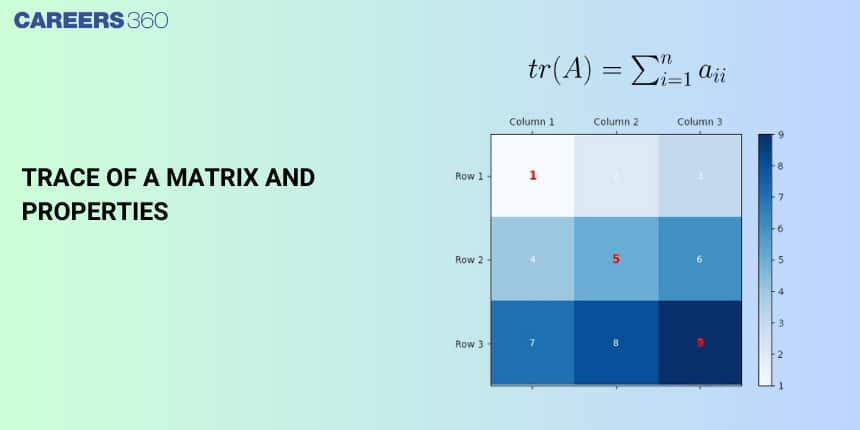Trace of a matrix and properties
Before we start with the concept of a trace of matrices, let’s first understand what is a matrix. A rectangular arrangement of objects (numbers or symbols or any other objects) is called a matrix (plural: matrices). A matrix is only a representation of the symbol, number, or object. It does not have any value. Usually, a matrix is denoted by capital letters. Matrix of order m × n, (read as m by n matrix) means that the matrix has m number of rows and n number of columns. In real life, we can use a trace of the matrix to construct Hamiltonians for quantum systems with discrete and finite sets of energy equivalence.
JEE Main: Study Materials | High Scoring Topics | Preparation Guide
JEE Main: Syllabus | Sample Papers | Mock Tests | PYQs
- Square matrix
- Trace of the matrix:
- Properties of a trace of the matrix:
- Solved Examples Based on Trace of Matrices

In this article, we will cover the concept trace of matrices. This category falls under the broader category of Matrices, which is a crucial Chapter in class 12 Mathematics. It is not only essential for board exams but also for competitive exams like the Joint Entrance Examination(JEE Main) and other entrance exams such as SRMJEE, BITSAT, WBJEE, BCECE, and more. A total of eight questions have been asked on this topic in Jee mains (2013 to 2023), one in 2013, one in 2021.
Square matrix
The square matrix is the matrix in which the number of rows
Trace of the matrix:
The sum of all diagonal elements of a square matrix is called the trace of a matrix. Lying along the principal diagonal is called the trace of A.
The trace of the matrix is denoted by Tr(A) or tr.A.
Let us consider the square matrix of order
Eg.
For a given matrix
Properties of a trace of the matrix:
Given below are some properties of the trace of a matrix. Let us consider two square matrices A and B
i) If A is a square matrix of order ‘n’ and k is a scalar quantity then the trace of multiplication of k and A is equal to the Multiplication of k into the trace of A.
Tr(kA)=k·Tr(A)
ii)If A is the square matrix of order ‘n x m’ and B be square matric of order ‘m x n then, the trace of the sum( or subtraction) of Matrix A and B is equal to the sum (or subtraction) of Trace of A and Trace of B.
Tr(A ± B) = Tr(A) ± Tr(B)
iii) If A is the square matrix of order ‘n x m’ and B be square matric of order 'm x n' then, the Trace of Matrix AB is equal to the Trace of matrices B A.
Tr(AB) = Tr(BA)
iv) If A is square matrices of order ‘n’ then, the Trace of Matrix A is equal to the Trace of the transpose of Matrix A.
Tr(A) = Tr(A’)
v) If A is the square matrix of order ‘n x m’ and B be square matric of order ‘m x n’ then, the trace of Matrix AB is not equal to the Trace of Matrix A multiplied by the Trace of Matrix B.
Tr(AB) ≠ Tr(A).Tr(B)
vi) if I is the Identity matrix of order ‘n’ then the trace of the identity matrix is equal to n.
Tr(I) =n
vii) Trace of zero or null matrix is always zero.
Tr(0)=0 S
Recommend Video Based on Trace of a Matrix:
Solved Examples Based on Trace of Matrices
Example 1: Let and
1) 1
2) 2
3) 0
4) 3
Solution:
Add (1) and (2), we get
Hence, the answer is the option 2.
Example 2 The number of all
1) 672
2)512
3)1024
4)256
Solution
Let matrix
So out of 9 elements, 3 elements must be equal to 1 or −1, and the rest elements must be 0.
Possible causes
Hence, the answer is the option 1
Example 3 Let
Statement 1:
Statement 2:
1)statement 1 is true; statement 2 is false.
2) statement 1 is true; statement 2 is true; statement 2 is not the correct explanation for statement 1
3)statement 1 is true; statement 2 is true; statement 2 is the correct explanation for statement 1
4)statement 1 is false; statement 2 is true;
Solution:
'
Statement 1 is true
Now,
Now, from (3)
So,
Adding
or
So,
So, statement -2 is also true.
But statement -2 is not the correct explanation of statement-I
Hence, the answer is option 2
Example 4: If the element of a matrix A is defined by
1) 14
2) 28
3) 0
4) 5
Solution:
Trace of a Matrix -
if
The sum of the elements of a square matrix
Since
Hence, the answer is option 3.
Example 5: Let A be a
(P) If
(Q) If
1) (P) is false and (Q) is true
2) Both (P) and (Q) are false
3) (P) is true and (Q) is false
4) Both (P) and (Q) are true
Solution:
So,
So (P) is false
For
Hence, the answer is the option 1
Also Read
15 Feb'25 11:01 AM
15 Feb'25 10:43 AM
14 Feb'25 12:44 PM
14 Feb'25 12:41 PM
14 Feb'25 11:14 AM
14 Feb'25 11:08 AM
14 Feb'25 11:02 AM
14 Feb'25 10:58 AM
14 Feb'25 10:55 AM
14 Feb'25 10:43 AM

